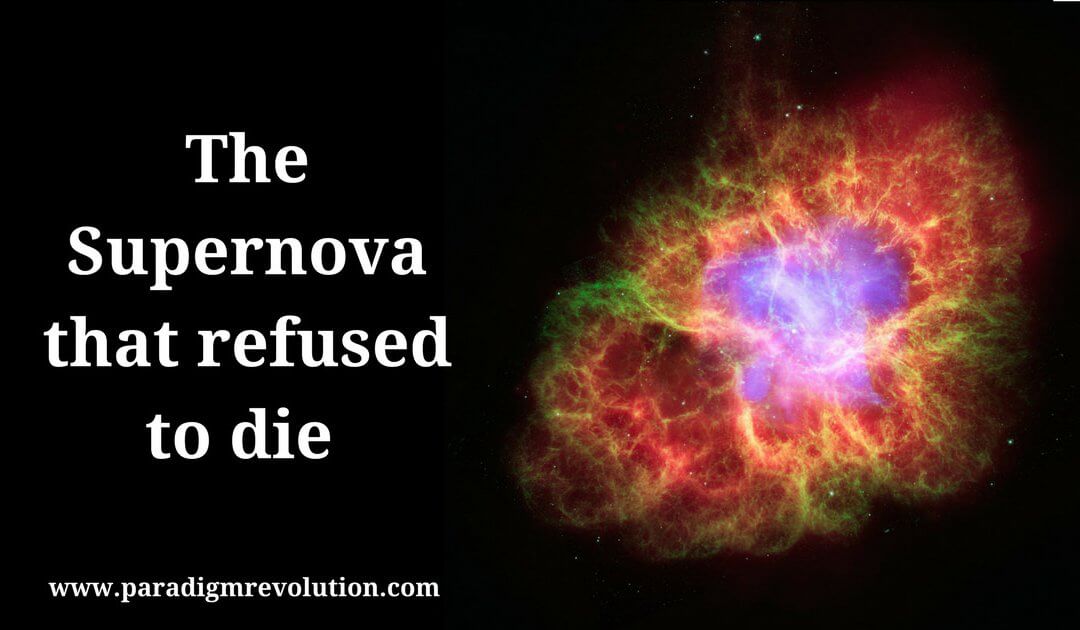The supernova that refused to die and what it can tell us about our universe
There are many articles in popular astronomy news that attract my attention because they report cases where the universe does something that defies current explanations. This is for the simple reason that current explanations are actually outmoded and not how the universe works, therefore observations will contradict current theories.
The Black Hole Principle is a much more accurate picture of the universe, which will also be eventually superseded, but for now and the foreseeable future, it is our best fit for the universe.
I read many articles which follow a theme – The Black Hole Principle fit the observations much better than current mainstream theories. A great example of such an article is the case of the supernova that refused to die.
A Rebel Star?
This is the story of supernova called iPTF14hls spotted by scientists in San Diego 2014. At first, the behaviour of this supernova appeared to fit the picture of an explosion of a dying star. These supernova events can be so great that they momentarily rival the brightness of an entire galaxy.
Except this supernova iPTF14hls, refuses to play by the rules. Instead of fading away, it has actually been observed to become brighter. Astronomers expected the supernova’s brightness to dim over the period of 100 days but this did not happen. To top it off, a supernova was seen in this same location in 1954 which means this could be the same event spanning 60 years!
This errant supernova led astrophysicist, Stanford Woosley at the University of California, Santa Cruz to remark to Space.com, “I’m not sure, and I don’t think anyone else is sure, just what the hell is happening. And yet it happened, and so it begs explanation.”
When observation does not match theory
I had to giggle to myself when I read this article. Like so many articles on astrophysics that I read, this demonstrates one of the key issues in science today. Scientists are so wedded to their current models of how the universe works that when repeated observations come forward to show them that they are wrong, they do not know what to do.
This so-called supernova is a perfect example of Black Hole Principle behaviour. The model of the universe currently held by astrophysicist is that the universe is a violent place, full of powerful explosions of things dying and colliding. How else would they explain the powerful signals they see coming from various part of the universe?
But the Black Hole Principle provides a different explanation. These bright events are not the result of violent deaths but of effortless creation from points all over the universe from the micro the macro. As the light tumbles in from higher dimensions and reaches the Perception Horizon that marks the boundary between this so-called 3-D world and dimensions beyond, it can be very bright and powerful.
It is effortless power because it is fuelled by higher dimensional processes far beyond what we can generate in this dimension. But as I have described before, the black hole creation process involves breathing – so sometimes you see a lot of light given out and sometimes the process appears relatively dormant – there are seemingly random fluctuations.
This is what is happening in the case of the supernova, iPTF14hls. It is probably the same object that has been observed since the 1950s but instead of being a star that has exploded as it died, it is the sign of creation. Sometimes it will appear dormant as less light is being transferred from higher dimensions and sometimes it will outshine a galaxy as the light being brought in is particularly strong.
Sometimes objects across the universe show very rapid fluctuations that yet again do not fit the violent explosion model. Yet astrophysicists stick to their theories despite the data and observations being in opposition to them.
From violence to effortless creation
The insistence of astrophysicists on violent explanations is understandable when you believe that the 3-D universe is all there is. The fact that their own calculations have revealed that what we can physically see and measure makes up less than 1% of the universe with most of it being a mysterious dark matter, has not persuaded mainstream scientists that other realms exist beyond their imagination.
In the 3-D world below the speed of light, the only events that can release the sort of light we see from supernovas are explosions.
But if we open up to a universe that exists on many planes, we start to realise that the source of all that we see around us is not some distant Big Bang but the universe is being created all the time at every level from higher dimensions.
And as the light from higher dimensions breathes our world into existence, it is effortlessly powerful and has no set point, but moves one way and then the other.
Hence we observe objects that defy the current thinking in astrophysics but absolutely fit The Black Hole Principle. This process gives rise to the gamma-ray burst repeaters and a lot of other observations that currently confound astrophysicists.
One day, maybe the consciousness of humanity will evolve beyond the violent urges we have and our collective tendency for destruction. Maybe that is when we will be ready to receive the new, more accurate picture of worlds beyond the one we see with our eyes being the gentle source of power and creation for our world.
Further Reading
Supernova defies understanding Space.com
For further information on The Black Hole Principle
Top 8 Predictions of the Black Hole Principle that even made me gasp
Image: Pixabay




Trackbacks/Pingbacks